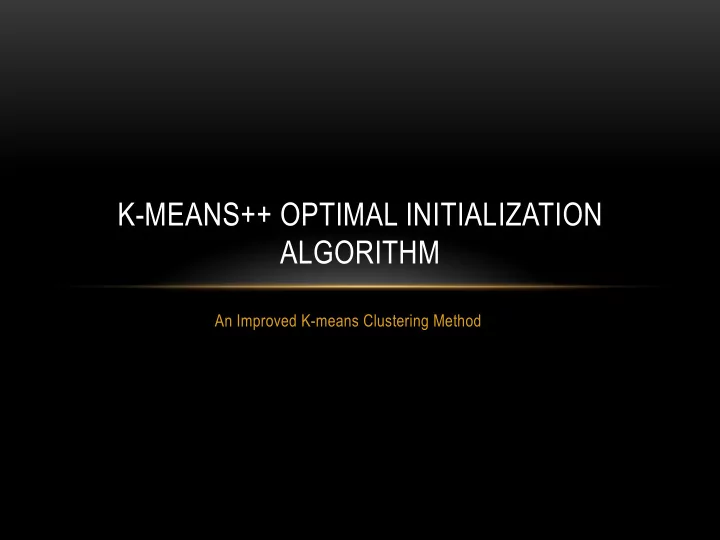

K-MEANS++ OPTIMAL INITIALIZATION ALGORITHM An Improved K-means Clustering Method
OVERVIEW K-means Clustering Algorithm • K-means++ Initialization Algorithm • Experiment • Datasets • Conclusion •
K-MEANS CLUSTERING ALGORITHM A well-known naïve clustering method. • Designed to find natural clusters in unclassified datasets. • Only requires a single input parameter - K • Uses random initialization technique for centroids. • Uses Euclidean distance to determine instances’ cluster assignments. • Calculates means of finished clusters then starts over. •
CLUSTERING EXAMPLE
MEAN CALCULATION AND RE-CLUSTERING
K-MEANS++ INITIALIZATION ALGORITHM Arbitrarily selects the first centroid. • Every other centroids selected based on distance from other centroids. •
EXPERIMENT Compared standard K-means and K-means++ methods. • Goal: to discover if either one of them produces better results than the other. • Setup: • Both methods run against 3 datasets with classes – Cluster, Iris, and Wine. • Each set has 3 classes which are used to verify the quality of the resulting clusters. • Quality in clusters is also determined by majority class • Fixed “arbitrary” setup to create a optimal and worst random centroid selection. • Both methods run against both centroid setups 3 times with a different K value. • Total of 36 trials. •
MULTIDIMENSIONAL DATA - CLUSTER
MULTIDIMENSIONAL DATA - IRIS
MULTIDIMENSIONAL DATA - WINE
RESULTS K-means++ proven to be better. • No reason to use standard K-means. • Still not perfect. •
IMPORTANT NOTES Imperfect simulation of K-means++ • Results could be better. • Results should give clearer favor to K-means++ •
REVIEW K-means Clustering Algorithm • K-means++ Initialization Algorithm • Comparison Experiment • Multidimensional Datasets • Results •
WORKS CITED • Aleshunas, J. (2013). Cluster Set. Alsabti, K., Ranka, S., & Singh, V. (1997). An effcient k-means clustering algorithm. • Arthur, D., & Vassilvitskii, S. (2007). K-means++: the advantages of careful seeding. • Philadelphia: Society for Industrial and Applied Mathematics Philadelphia. Fisher, R. A. (1936). Iris Flower Data Set. • Forina, M. (1988). Wine Recognition Data. PARVUS: An extendable package of programs for • data exploration, classification and correlation . Genoa, Italy: Institute of Pharmaceutical and Food Analysis and Technologies. Inaba, M., Katoh, N., & Imai, H. (1994). Applications of weighted Voronoi diagrams and • randomization to variance-based k-clustering. SCG '94 Proceedings of the tenth annual symposium on Computational geometry (pp. 332-339). New York: ACM. MacKay, D. (2003). An Example Inference Task: Clustering. In D. MacKay, Information Theory, • Inference and Learning Algorithms (pp. 284-292). Cambridge University Press. Shaefer, I. (2013). Cluster Set Modified. •
Recommend
More recommend